Iron contamination is one of the most common well water problems because of its abundance in the Earth’s core. Although it doesn’t pose any health risks and is only considered to be an aesthetic nuisance by the Environmental Protection Agency (EPA), iron in water can still change its color, taste, and smell.
Iron levels in water across the United States rarely exceed 10 mg/L, but even 0.3mg/L of iron is enough to decrease the quality of water for your daily consumption. So, most well-owners look for ways to remove iron in well water, which often requires installing a whole house well water iron filter.
An iron water filter is a water filtration system that uses different treatment methods such as air oxidation or ion-exchange to remove iron from water.
The best iron removal system for well water in 2023 is the Springwell WS1 Well Water Filter. It uses air injection & oxidation to remove 7 ppm of iron, 8ppm of hydrogen sulfide and 1 ppm of manganese from water.
Here are the 5 most important factors to consider in a whole house iron filter system:
- The level of iron concentration in your water
- Your water source (tap or well water).
- The system’s filtration technology (i.e air oxidation, ion-exchange, e.t.c)
- NSF certifications
- The product warranty
Whole House Iron Removal Systems Comparison Table
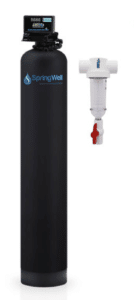
- Flow Rate: 12 gpm
- Contaminants Removed: 8 ppm of hydrogen sulfide, 7 ppm of iron, 1 ppm of manganese
- NSF Certification: Not specified
- Warranty: Lifetime on both the tank and valves
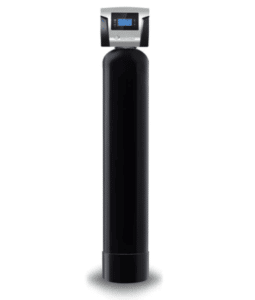
- Flow Rate: 7 gpm
- Contaminants Removed: 30 ppm of iron, 7 ppm of manganese, 5 ppm of hydrogen sulfide
- NSF Certification: NSF/ANSI 42, 44, 61, and 372
- Warranty: Lifetime
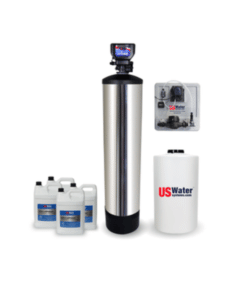
- Flow Rate: 10 gpm
- Contaminants Removed: 30 ppm of hydrogen sulfide, 20 ppm of iron, 1 ppm of manganese
- NSF Certification: Not specified
- Warranty: Lifetime on the tank, 10 years on the valves and electronics, 5 years on the precise injection panel
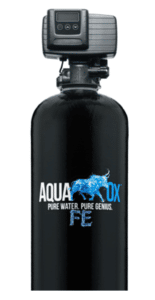
- Flow Rate: 12 gpm
- Contaminants Removed: 4 ppm of hydrogen sulfide, 7 ppm of iron
- NSF Certification: Not specified
- Warranty: 10-year
Best Iron Water Filters for Well Water:
- Springwell WS1– It can remove up to 8 ppm of hydrogen sulfide, 7 ppm of iron, and 1 ppm of manganese from water. | (Jump to Review)
- SoftPro IronMaster – It is a budget-friendly iron filtration system that can remove iron up to 30 ppm and manganese up to 7 ppm. | (Jump to Review)
- Matrixx Infusion System – The Matrixx Infusion System can handle hydrogen sulfide up to 30 ppm and iron up to 20 ppm. | (Jump to Review)
- AquaOX FE – It removes ferrous iron up to 7 ppm by oxidizing it with fresh air pocket. | (Jump to Review)
1. Springwell WS1 Ultra-Efficient Whole House Iron Filter for Well Water
We stand by almost every water treatment product the Springwell brand has on offer simply because they’re made of extremely high-quality materials, and the Springwell WS1 iron filter model is no exception. It is the most effective whole-house water filter system for a standard American private well that has a mild excess of iron, hydrogen sulfide, and manganese in its water source.
Even better, Springwell’s 12 gallons per minute (gpm) flow rate is more than capable of providing water for houses with one to four bathrooms without causing any drops in water pressure.
Thanks to its effective use of Air Injection Oxidation technology, the Springwell WS1 can remove up to 8 ppm of hydrogen sulfide, 7 ppm of iron, and 1 ppm of manganese from water. This means that if the water testing shows that the contaminants are within those ranges, you’ll have crystal-clear water that bears no extra taste or odor.
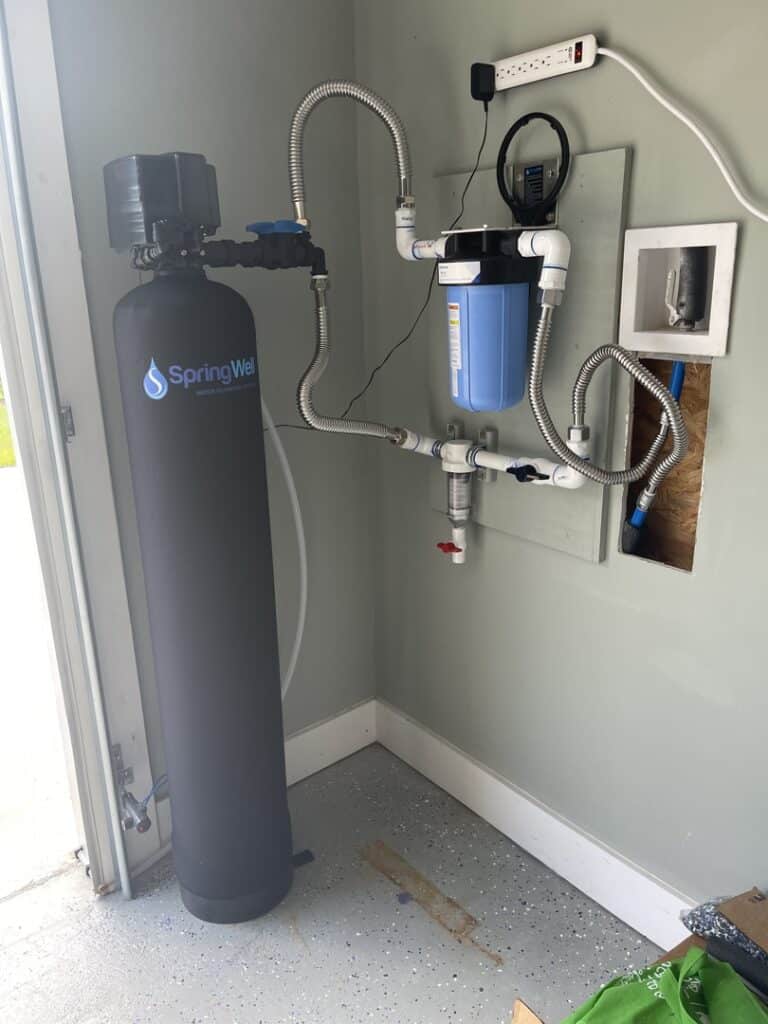
The Springwell WS1 AIO system is a single-tank design that maintains a fresh air pocket on top of the tank. When the water passes through this pocket, the air inside it oxidizes the minute particles of hydrogen sulfide, iron, and manganese. Thanks to this feature, the Springwell can remove both ferrous and ferric iron from water.
As we already mentioned, small molecules get bigger and clump together when oxidized. That way, when the oxidation process ends and the water makes its way through the filter media of the device, the problematic molecules are big enough to be filtered out.
In the case of the Springwell WS1, the filtration media is a bed of green sand fusion that traps oxidized molecules.
Before you start worrying that the filtration media might wear off with time, we should also tell you that green sand fusion is very easy to maintain and regenerate. Plus, the Springwell WS1 has a pre-programmed daily backwash cycle that doesn’t require you to do anything to clean the filter, either.
To optimize the backwash and regeneration properties of the filtration system, Springwell engineers developed a technology called Empress Vortech. Not only does this tech ensure that the whole operation takes place within a single-tank design, but also, it guarantees that the bed of green sand is cleansed thoroughly and regenerated efficiently during the backwash cycle.
Are you worried that the pre-programmed character of the device will rob you of control? You shouldn’t be because, like all other Springwell water treatment devices, the Springwell WS1 has a system head that can be easily monitored and controlled through a BlueTooth app the manufacturer provides.
This way, on days when you need to use or have used excessive amounts of water, you can run a manual backwash to keep the system as efficient as possible.
While there are plenty of reasons to buy the Springwell WS1, there’s one drawback we need to share as well. As you may have already noticed, the contaminant removal capacity of the Springwell WS1 pales compared to the other devices on our list. So, when the water has too much iron or hydrogen sulfide, it’s not really the ideal solution.
In addition, despite its compact single-tank design and low maintenance requirements, its installation is pretty complicated, requiring many different plumbing tools and a certain dexterity in the profession. So, should you purchase this device, we recommend you enlist the services of a professional plumber to avoid further complications during installation.
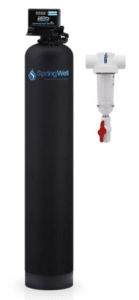
- Flow Rate: 12 gpm
- Contaminants Removed: 8 ppm of hydrogen sulfide, 7 ppm of iron, 1 ppm of manganese
- NSF Certification: Not specified
- Warranty: Lifetime on both the tank and valves
- Made of high-quality materials
- Great flow rate capacity
- Low maintenance
- Lifetime warranty
- Low contaminant removal capacity
- Installation requires professional assistance
- Expensive unit
2. SoftPro IronMaster Iron Removal System for Well Water
The SoftPro IronMaster is one of the most affordable iron removal systems on the market, but this doesn’t mean that it is any less efficient than the other higher end units. On the contrary, its capability of removing up to 30 ppm of iron and 7 ppm of manganese is nothing short of exemplary, and that’s why we were so impressed by it. And, as a cherry on top, it has all the relevant NSF certifications, which none of the other recommendations have!
Whether you’re in the market for a water softener or an all-purpose filtration unit, SoftPro has a way of offering a budget-friendly product with innovative technology. Their iron removal system is no exception to that rule.
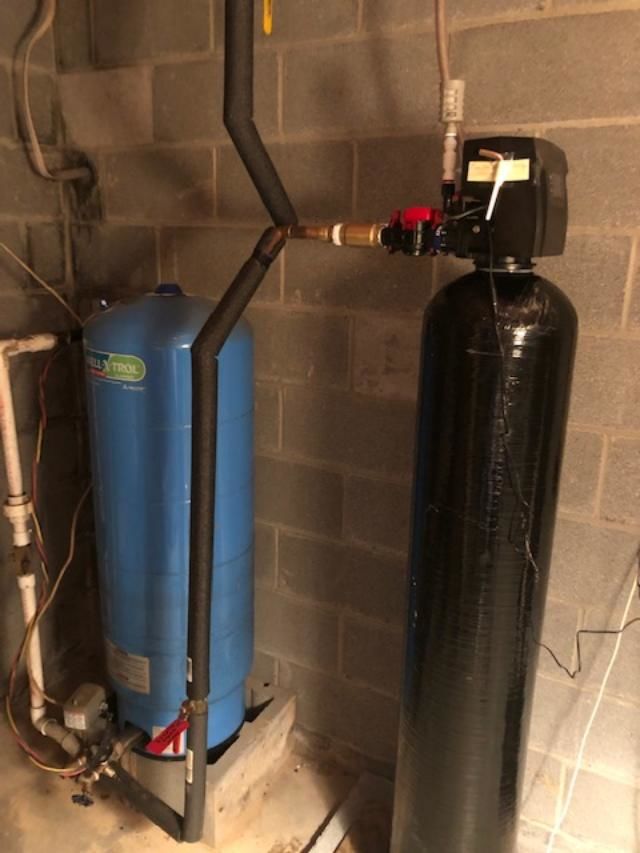
Like all of its peers that we evaluated, the SoftPro IronMaster also uses Air Injection Oxidation to oxidize particles of ferrous iron, manganese, and hydrogen sulfide. However, the succeeding filtration method is nothing like the bed of green sand fusion we saw on the Springwell WS1 or the traditional catalytic carbon of the Matrixx Infusion System.
Instead, the IronMaster employs Katalox filter media, which is a new filtration technique developed by German engineers. Katalox filters are the most effective iron removal instruments simply because they’re coated with high concentration manganese dioxide.
Thanks to this innovative technology, the unit has more filtration surface, and the air injected through manganese dioxide has an amplified oxidation capacity. That’s why this particular filtration unit has such impressive removal rates.
In addition to that, most iron filtration systems utilize chemicals like chlorine or potassium permanganate to cleanse their system during the backwash cycle. That’s not the case with the SoftPro IronMaster. It only requires water to drain the contaminants that are trapped by its Katalox media.
Its installation is a breeze as well, and that’s especially the case if you get the quick-connect hose kit. Depending on current promotions, you may get it for free as a courtesy from the brand, or you might have to pay $79 for it, but it’s definitely worth it as it eases the installation process to a great extent.
Still, if you aren’t sure how to go on about it, the product page has a very thorough video guiding customers through the process.
When it comes to downsides, despite the superiority of Katalox in removing iron, the technology is not as effective when it comes to removing hydrogen sulfide. Especially when compared to the hydrogen peroxide capacity of the Matrixx Infusion, its removal rate of 5 ppm is quite humble.
Lastly, depending on the contaminant levels of your water, you’ll need to replace the filtration media once every 5 to 10 years.

- Flow Rate: 7 gpm
- Contaminants Removed: 30 ppm of iron, 7 ppm of manganese, 5 ppm of hydrogen sulfide
- NSF Certification: NSF/ANSI 42, 44, 61, and 372
- Warranty: Lifetime
- Easy installation
- Innovative Katalox filter media
- Incredible iron and manganese removal rate
- Affordable
- Doesn’t require chemicals to backwash
- Low flow rate compared to other iron filtration systems on our list
- You might need to replace its filter once every 5 to 10 years
3. Matrixx Infusion Iron Filter System for Extreme Iron Levels
The Matrixx Infusion System has impressed us with its iron removing capacity that can reach up to 20 ppm. But even more impressive is its unprecedented hydrogen sulfide removal rate of 30 ppm.
Similar to iron, hydrogen sulfide is a common problem for private well owners all across the United States. It can be either naturally found in and around underground water sources, or it can be produced by sulfide bacteria that can contaminate a well when the water supply is rich with sulfur.
Similar to other iron filtration systems, the Matrixx Infusion employs AIO technology to oxidize small hydrogen sulfide, iron, and manganese particles. But it stands out with its use of hydrogen peroxide as an oxidizing agent in addition to the commonly used oxygen and catalytic carbon to filter out the trapped elements.
When the water is rich in hydrogen sulfide, it acquires a sulfur smell that is easily mistaken for sewage odors or rotten eggs. Municipal water suppliers utilize disinfectants like chlorine and chloramines to remove hydrogen sulfide from water, but using them to sanitize a private well regularly may be too arduous. This is where the Matrixx Infusion System comes into the picture. With its 30ppm capacity to remove hydrogen sulfide from water, there’s simply no well water it can’t sanitize.
As hydrogen peroxide is an even stronger oxidizer than pure, dissolved oxygen, it can easily handle high levels of dissolved molecules. What’s better, it can kill pathogenic organic compounds like bacteria upon contact, so no hydrogen sulfide bacteria will enter the piping system of your house.
The catalytic carbon media of this system is pre-programmed to backwash and regenerate once every two days, and its superfilter control valve ensures that the process is carried out thoroughly. Like Springwell, the Matrixx Infusion employs Vortech technology that creates a vortex to optimize cleansing during the backwash cycle.
Similar to the backwash and regeneration process, this particular system operates through the air injection process with maximum efficiency. To that end, it uses a tech piece referred to as Stenner Precision Injection Panel, and it does exactly what it says: precise air injection.
The flow rate of the Matrixx Infusion is a bit lower than the Springwell WS1, with a maximum of 10 gpm, but that’s still enough for small houses with one to three bathrooms. On the other hand, if you have a crowded household and are looking for more water pressure and a higher flow rate, there are also 15 gpm, 20 gpm, and 25 gpm options of the Matrixx Infusion, which come with a higher price tag.
That being said, the Matrixx Infusion System is already the most costly item in this article, and all the great innovative components it features adds to the expenses in the long run. Its carbon filter valve and electronic parts entertain only a 10-year warranty.
The case is even worse for its precise injection panel that has a 5-year warranty. So, when these machine parts run their course, you’ll have to replace them, which will cost you a lot. Lastly, similar to the Springwell WS1, it’s best to hire a professional to carry out its installation as it’s quite complex.

- Flow Rate: 10 gpm
- Contaminants Removed: 30 ppm of hydrogen sulfide, 20 ppm of iron, 1 ppm of manganese
- NSF Certification: Not specified
- Warranty: Lifetime on the tank, 10 years on the valves and electronics, 5 years on the precise injection panel
- Unprecedented hydrogen sulfide and iron removal capacity
- Great backwash and air injection properties
- Made of high-quality materials
- Good flow rate
- Low maintenance
- Fairly expensive
- Innovative components have limited warranty
- Installation requires professional assistance
4. AquaOX FE Whole House Iron Removal System
The AquaOX FE doesn’t have the impressive removal rates of the Matrixx Infusion System above, but it’s still quite an efficient system for removing iron from well water. And, unlike the previous filtration units we’ve covered so far, its installation can easily be handled by avid DIY-ers as long as they follow the manufacturer’s guide to the letter.
The AquaOX FE can easily take care of ferrous and ferric iron as long as their levels are less than 7 ppm. On top of that, its flow rate rarely falls below 12 gpm.
With these numbers, the unit is capable of providing iron-free water for households that have one to four bathrooms. In the end, you’ll enjoy the benefits of water-related appliances without worrying about stains, better-tasting beverages and food, and a cleaner, low-maintenance overall piping system.
Similarly to the Springwell WS1, the AquaOx FE employs a tank with a compressed air pocket at the top. When the water passes through this air pocket, dissolved oxygen starts oxidizing iron and hydrogen sulfide particles.
A filter media bed then blocks the passage of the molecules to the piping system of the household by trapping them. The automated daily backwash cycle of the device flushes out the accumulated iron and hydrogen sulfide from the media bed. A regeneration cycle accompanies the backwash process by replenishing the air inside the compressed pocket.
Most water treatment units on the market can’t provide water during the regen cycle – at least, not without causing a drop in water pressure. One reason we liked the AquaOx FE is that you can still have untreated water during its regeneration process without a significant drop in water pressure.
The whole process of flushing out trapped contaminants and replenishing the oxidizing agent inside the tank roughly lasts about an hour. The first quarter of this period consists of backwash, in which a double vortex thoroughly cleanses the filtration media. The rest is the air recharge and a rapid rinse of the system.
Of course, like all the other products we evaluated, the AquaOx FE allows you to adjust the regeneration cycle to optimize its efficiency. That’s an especially handy feature when you overwork the device or when you’ve been away for more than a day and haven’t put the device in service at all.
That being said, if you don’t regenerate the AquaOx FE for more than three days, the accumulated iron will probably strengthen its hold over the media. After that, it’ll be difficult to remove it no matter how many back-to-back backwash cycles you manually run, and the device will become inefficient.
Considering that this particular unit only has a 10-year warranty, it’s best to make sure you follow the manufacturer’s recommendations. We should also note that, even though the manufacturer somewhat compensates for the short warranty period with a 12-month money-back guarantee, it’s still a disadvantage compared to the other units.
Besides its modest warranty, unlike the Springwell WS1 or the Matrixx Infusion, the AquaOx FE isn’t really effective against hydrogen sulfide or manganese. It can only remove a maximum of 4 ppm of the former, and its removal rate for the latter is so insignificant that the manufacturer didn’t even feel the need to specify it.
Despite its relatively-short warranty and humbling removal capacity, it’s not exactly an affordable filtration system, but it’s still second in affordability to our budget choice: the SoftPro IronMaster.

- Flow Rate: 12 gpm
- Contaminants Removed: 4 ppm of hydrogen sulfide, 7 ppm of iron
- NSF Certification: Not specified
- Warranty: 10-year
- Easy installation
- Double vortex backwash cycle
- Great flow rate
- Low maintenance
- 10-year warranty is quite short, especially considering the lifetime warranty of other devices we reviewed
- Ineffective against hydrogen sulfide and manganese
Our Review Criteria for Iron Filtration Systems
A whole-house well water filtration system shouldn’t be evaluated by only its capacity to remove certain foreign elements from water. There should also be other considerations, like how affordable it is and what it takes to maintain it.
That’s why we evaluated iron filters with the following criteria:
- Contaminants Removed
- NSF Certification
- Filtration Technology
- Ease of Installation
- Maintenance Requirements
- Warranty
- Price
Contaminants Removed
The contaminant an iron filter can and should remove is pretty self-evident: iron. But fortunately, iron filters remove more than just iron.
Most of these systems are quite effective against other aesthetic nuisances that can change the color, taste, and smell of the water, like hydrogen sulfide and manganese. While hydrogen sulfide can make water smell and taste like rotten eggs, manganese can appear in the shape of black sediment in well water.
If there are high iron or manganese levels in your well water, you can’t pick a better filtration system than the SoftPro IronMaster. It can remove up to 30 ppm of iron and 7 ppm of manganese, which makes it the best device to remove these two minerals.
On the other hand, if hydrogen sulfide is your primary problem, the Matrixx Infusion System should be your go-to well water filtration unit. It can remove a staggering 30 ppm of hydrogen sulfide from your water supply.
| Iron filter systems | Iron | Hydrogen sulfide | Manganese |
|---|---|---|---|
| Springwell WS1 | 7 ppm | 8 ppm | 1 ppm |
| Matrixx Infusion | 20 ppm | 30 ppm | 1 ppm |
| AquaOx Fe | 7 ppm | 4 ppm | Not specified |
| SoftPro IronMaster | 30 ppm | 5 ppm | 7ppm |
NSF Certification
The National Sanitation Foundation (NSF) is a non-profit organization that holds any product with potential health implications up to certain standards. To this end, independent labs test and evaluate products varying from automotive parts to food items and certify them if they’re within the NSF regulations.
Of course, it’s also important to test, certify, and confirm the health claims of any water-related technology, including softeners and filtration systems. In this sense, the NSF certifies whether water filtration devices are capable of removing what the manufacturer claims they do and whether the materials used in the making of the device are safe.
The certifications the NSF gives to iron filters are:
- NSF/ANSI 42: The NSF 42 certification pertains to the aesthetic claims of a device. If a filtration unit holds this particular certification, it means that it can produce tasteless, colorless, and odorless water, as water should be. As producing aesthetically pleasing water is the main purpose of an iron filter, it’s the certification that’s most significant for our list.
- NSF/ANSI 44: Mostly applied to water softeners, the NSF 44 certification guarantees that the resin media is capable of ion exchange and that the tanks and valves possess structural integrity. The tanks, valves, and filtration media of some iron filters also have this certification.
- NSF/ANSI 61: Unfortunately, not all water filtration systems are made of materials that are safe for drinking water. Some of them might leach microplastics into the water, and some of them may have a coating that wears off over time, contaminating the water further instead of purifying it. The NSF 61 certification assures customers that the components of a product bear no such risks.
- NSF/ANSI 372: The NSF 372 is proof that the product’s parts are all lead-free and there’s no risk of lead contamination by the product itself.
However, despite the relevance of these certifications, most water treatment manufacturers don’t have their devices independently tested and NSF-certified. Out of all the products on our list, only the SoftPro IronMaster carries all these certifications.
Although manufacturers like the US Water Systems (the manufacturer of the Matrixx Infusion System) and AquaOx claim that their filtration units are certified, we could find no specification about their claims and no proof that they really are certified.
Regardless, our own tests showed these products are capable of removing iron, hydrogen sulfide, and manganese in the way they claim to do.
| Iron filters | NSF/ANSI 42 | NSF/ANSI 44 | NSF/ANSI 61 | NSF/ANSI 372 |
|---|---|---|---|---|
| Springwell WS1 | Not specified | Not specified | Not specified | Not specified |
| Matrixx Infusion | Not specified | Not specified | Not specified | Not specified |
| AquaOx Fe | Not specified | Not specified | Not specified | Not specified |
| SoftPro IronMaster | Certified | Certified | Certified | Certified |
Filtration Technology
There are two types of iron found in water: ferric iron, also referred to as oxidized iron, has big, reddish particles and is insoluble; and ferrous iron, that’s invisible and totally dissolved. The ion exchange media of water softeners can trap ferric iron as long as it’s within the unit’s capacity, but removing dissolved ferrous iron requires more than the ion exchange technology.
To remove the dissolved particles of ferrous iron from water, iron filters employ a specific technology called Air Injection Oxidation (AIO). In this process, the water passes through an air pocket where dissolved oxygen or some other oxidizing agent is introduced to it.
At the end of the AIO process, the ferrous iron molecules are oxidized, meaning that they have become ferric iron. The process shows the same effects on hydrogen sulfide and manganese, thus enabling the filter media of the devices to handle big amounts of these substances.
All the products on our list sport AIO technology, but the Matrixx Infusion System shines among its peers, thanks to its use of hydrogen peroxide in addition to oxygen as an oxidizing agent to remove hydrogen sulfide.
Additionally, the Katalox filtration media of the SoftPro IronMaster is quite an innovative and impressive piece of technology that boosts the iron removal capacity of the device quite a lot.
| Iron filters | Filtration technology |
|---|---|
| Springwell WS1 | Air Injection Oxidation |
| Matrixx Infusion | Air Injection Oxidation + Hydrogen Peroxide |
| AquaOx Fe | Air Injection Oxidation |
| SoftPro IronMaster | Air Injection Oxidation + Katalox Filter Media |
Ease of Installation
Despite the technical similarities between the systems on our list, their installation requirements vary quite a bit. Additionally, even though some of these units come with proper instruction manuals that lead you through the process step-by-step, some are just the opposite of helpful.
Springwell WS1 has an amazing PowerPoint presentation that lists all the necessary equipments you need to carry out its installation accompanied by visuals that show you exactly what to do. But if you don’t have any experience in plumbing, it’s still better to seek the assistance of a professional plumber since it’s a complicated device to install.
SoftPro, on the other hand, offers a hose kit that eases the installation process to a great extent. The company sometimes just gives it away for free if you’re lucky; other times, though, it might cost you only $79, which we consider to be a small price to pay if you’re a DIYer with no plumbing experience.
| Iron filters | Ease of installation |
|---|---|
| Springwell WS1 | Plumber required |
| Matrixx Infusion | Plumber required |
| AquaOx Fe | DIY-friendly |
| SoftPro IronMaster | DIY-friendly |
Maintenance Requirements
Many whole-house water filters and reverse osmosis systems currently on the market require you to replace the filters once every six to twelve months. But there are no such worries with any of the whole-house iron filters on our list.
This is mainly because all the systems we reviewed in this article have state-of-the-art automatic backwash and regeneration cycles that clean their filter media regularly.
Essentially, they’re all low-maintenance products, the only exception being the SoftPro IronMaster. Despite its innovative character, the Katalox media filter of the SoftPro IronMaster needs to be replaced once every five to ten years.
That being said, you can monitor the operations of the Springwell WS1 and Matrixx Infusion on your smartphone or tablet via the Bluetooth apps the manufacturers provide. The SoftPro IronMaster and the AquaOx Fe don’t have such a feature. Their system heads mounted on top of their tanks will have to suffice.
Also, the Springwell is made of high-end materials, so there’s little chance that it’s going to suffer from dings and other damage. Although we didn’t throw the systems into walls to test their sturdiness, we imagine that is not the case for the SoftPro or the AquaOx.
Lastly, if you use any of these devices to reduce iron levels higher than their indicated capacity, they’ll quickly become ineffective.
| Iron filters | Maintenance requirements |
|---|---|
| Springwell WS1 | Low |
| Matrixx Infusion | Low |
| AquaOx Fe | Low |
| SoftPro IronMaster | Need to replace the filter every 5 to 10 years |
Warranty
Warranty is a testament to how much the manufacturer trusts their product. It also gives you an idea about the life expectancy of the product you just purchased.
In that sense, the Springwell WS1 and the SoftPro IronMaster shine with their lifetime warranty on both their tanks and valves. In addition, the Springwell WS1 comes with a 6-month money-back guarantee.
The AquaOx Fe, however, comes with only 10 years of warranty. But its money-back guarantee option is 12 months.
| Iron filters | Warranty |
|---|---|
| Springwell WS1 | Lifetime on the tank and valves |
| Matrixx Infusion | Lifetime on the tank, 10 years on the valves and electronics, 5 years on the precise injection panel |
| AquaOx Fe | 10 years |
| SoftPro IronMaster | Lifetime on the tank and valves |
Price
Normally, the price of iron filters ranges between $1,200 – $3,000, but our list doesn’t feature products on either end of the range. Instead, the price range of the filtration units included in our list is $1,519 – $2,215, the most affordable one being the SoftPro IronMaster and the most expensive being the Matrixx Infusion.
Given the high removal capacity of the SoftPro IronMaster, we can say that you’ll be getting more than you signed up for.
| Iron filters | Price |
|---|---|
| Springwell WS1 | $2,204.09 |
| Matrixx Infusion | $2,215.41 |
| AquaOx Fe | $1,999.00 |
| SoftPro IronMaster | $1,519.00 |
How Water Gets Contaminated by Iron
As we said, iron is basically everywhere on Earth. If a private well draws water from an underground water reservoir that’s surrounded by iron-rich soil and rocks, iron is inevitably going to end up in the water.
But that’s not the only way iron can end up in the water supply. These underground water reservoirs (also referred to as aquifers) aren’t exempt from what’s going on above the ground. On the contrary, they’re mostly formed and fed by surface water that soaks into the ground.
Especially in times of rain and flood, the moving bodies of water can pick a plethora of elements, iron among them, from the surroundings and carry it to the groundwater your well is built upon.
In addition, the presence of iron in well water can sometimes be the work of studious iron bacteria that produce iron hydroxide deposits in and around the water source. These bacteria are capable of oxidizing and immobilizing iron inside the water, giving the water its reddish hue and giving well-owners a new headache.
Lastly, iron can get into water due to corrosion in the piping system of your house or inside a water tank. Since a whole house filtration system can’t prevent or stop rust inside the piping system, it’s best to call a plumber to inspect the pipes before settling on a water treatment unit.
Types of Iron in Water
There are four types of iron that can be present in water:
- Ferrous iron: Ferrous iron is the iron that’s totally dissolved in water, and that has tiny particles, so it’s difficult to detect its presence with the naked eye. Because of this, it’s also often referred to as clear iron. Typically, it’s either rain or snowmelt that picks it up from natural deposits, dissolves it, and carries it to the underground water sources. However, surface water sources like rivers and lakes hardly have any ferrous iron because when it comes into contact with oxygen, it oxidizes and turns into ferric iron.
- Ferric iron: You’ve probably already seen ferric iron since it’s basically rust. When other forms of iron are exposed to oxygen, they oxidize. Any iron deposit in appliances, piping, tanks, or even well components that comes in contact with air and your well water has the potential to contaminate your water with ferric iron. However, this is easy to identify, since it’s insoluble and red.
- Organic iron: As you may deduce from its name, organic iron is the work of iron bacteria. More precisely, it’s ferrous iron that’s been metabolized by iron bacteria. Water with organic iron in it will have a slimy character and, you’ll likely see iron deposits that look like tiny jellyfish in the water. The bacteria will also form iron scum inside the water. Sometimes, the water might even have a glossy layer on its surface, as if some oil was poured over it. If you have organic iron in your water supply, you might have seen that glossy layer in toilet tanks.
- Colloidal iron: Colloidal iron has even tinier particles than those of ferrous iron, but unlike ferrous iron, it also has a reddish color that might be visible in the water. Moreover, these particles are electrically-charged, so they stay in suspension inside the water and present quite a challenge for water treatment units. Luckily, though, the presence of colloidal iron in water is quite rare.
The Effects of Iron in Water
EPA has established that iron in water is not a health hazard. On the contrary, our bodies need iron as a nutrient and iron deficiency is pretty common.
Although too much iron can cause damage to the heart, liver, and endocrine organs, it’s almost impossible to consume too much iron from water alone, even when there are high levels in it. However, the presence of iron in water is definitely an aesthetic nuisance, and, as such, it’s regulated under the National Secondary Drinking Water Regulations (NSDWRs).
According to NSDWRs, the iron levels in drinking water should be no more than 0.3 mg/L. Otherwise, it’ll affect the color, taste, and smell of the water. The color of the water that comes out of your faucets might turn red and start tasting and smelling like metal.
Even worse, water that’s contaminated by ferric iron will also have an impact on the quality of food and beverages. You may like your tea dark and your coffee black, but iron will make these beverages blacker than you’d expect, and it can have the same effect on essential food items like potatoes.
Appliances and clothes washed with iron-rich water aren’t exempt from its consequences either. Depending on the iron levels, they might have yellow, red, or even brown stains.
Insoluble ferric iron might also lead to clogging in the piping system and appliances that work with water, like laundry machines and dishwashers.
In short, if your water supply has more than 0.3 mg/l of iron, it’s best to install an efficient iron filtration system. This way, you’ll prolong the lifespan of appliances and clothes, ensure that the taste of beverages and food is up to a standard, and protect the piping system of your house.
Frequently Asked Questions
The best way to remove iron from water is by installing an iron filter.
If your well water supply has a reasonable amount of iron (up to 7 ppm), the number one product on our list, the Springwell WS1, will do the job efficiently and for years on end. On the other hand, if iron is present in your water in excessive amounts, it’s best to invest in a stronger filtration system like the SoftPro IronMaster or the Matrixx Infusion System.
When you do it yourself, depending on the size of the well and the amount of sanitary product you’re going to use, it may cost you only up to $80. If you hire professionals, the costs can reach up to $200, which is still cheaper than installing a water treatment unit.
However, if the presence of iron stems from the underground water source, it’ll re-enter the system unless you keep on chlorinating your well regularly. So, despite its affordability, chlorination may require too much commitment from you and may also not be as cost-effective as an iron filtration system in the long run.
Still, if you want to learn how to chlorinate a well, head over to the guide we use and recommend, prepared by Oregon State University.
Price of iron filters ranges between $1,200-$3,000. The average price for a high-quality iron water filter is around $2,000.
That being said, the price range of the devices included in our list is $1,519 – $2,215, with their average equalling $1,982. The most affordable filtration unit we reviewed is the SoftPro IronMaster ($1,519), and the most expensive one is the Matrixx Infusion System ($2,215).
The tools and services required to install an iron filter depend on the manufacturers’ specifications. DIY-ers might be able to install the AquaOx FE or the SoftPro Iron master by following the installation guides, but it’s best to contact professional plumbers for the other two products.
Similarly, the tools needed to complete installations of the four products listed above vary. While the quick-connect hose kit the SoftPro provides might make that particular installation easier, to install the other filtration systems, you will need:
– Water connectors
– PVC nipples
– Plumbers’ tape
– Zip ties
– Threaded elbows
– Wrench
– Hose clamps
– Drain lines
– Batteries
It’s always best to consult with the manufacturer before the installation to make sure you have all the necessary items.
The average lifespan of an iron filtration system depends on a plethora of variables:
– The manufacturer
– Whether the system has a circuit board or complicated/fragile electronic parts
– The levels of contaminants it has to deal with
– The materials it’s made of
– How well you take care of it
That said, a whole house iron filtration system should typically serve you 15 to 20 years. Units that are made with high-quality materials, like the Springwell WS1, can exceed these expectations as long as you properly maintain them.
– Springwell Water Systems: Springwell is one of the best brands for all kinds of water filtration units, from whole-house systems to water softeners and iron filters. Their success is mainly due to the high-quality material the company uses to make these filters and the reliability of the data they provide.
– SoftPro: SoftPro tends to bring together technological innovation and affordability in the same package. The case is the same when it comes to iron filtration devices. They even have their products tested and certified independently.
– US Water Systems: US Water Systems is a brand that oversees the manufacture and distribution of many great filtration systems and softeners like the Matrixx Infusion or the Fleck series.
Conclusion
Iron is a common problem for well water owners because it changes the taste, odor, and color of drinking water. Hydrogen sulfide is even worse as it can release a stench like sewage or rotten eggs.
Luckily, the iron filtration systems we’ve reviewed above can efficiently take care of both issues. If you have reasonable amounts of iron (5 to 7 mg/L) and hydrogen sulfide (3 to 4 mg/L) in your water supply, we recommend the Springwell WS1 or the AquaOx FE, as these are high-quality, long-lasting devices.
On the other hand, if the hydrogen sulfide content in your well is higher, your go-to product should be the Matrixx Infusion system because it can remove up to 30 ppm of hydrogen sulfide particles from water. For excessive amounts of iron, the SoftPro IronMaster is an ideal choice since not only is it capable of removing up to 30 ppm of iron, but it’s also quite affordable.
Families may enjoy better-tasting, safer water from their outdoor wells by using the best iron filter for well water. It reduces rust buildup and obstructions in water pipelines and fixtures. In addition to protecting water appliances, a good iron filter also ensures long-term optimal performance, especially when used in conjunction with a water softener.